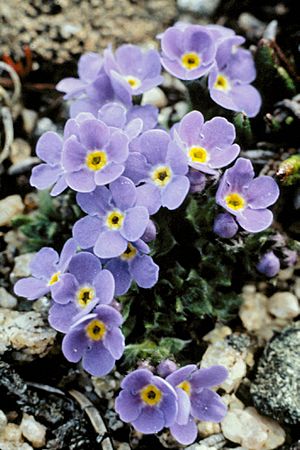Forget-me-not facts for kids
Quick facts for kids Forget-me-nots |
|
|---|---|
 |
|
| Alpine Forget-me-not | |
| Scientific classification | |
| Kingdom: | |
| (unranked): | |
| (unranked): | |
| (unranked): | |
| Order: |
(unplaced)
|
| Family: | |
| Genus: |
Myosotis
|
| Species | |
|
about 50 |
|
Myosotis (say: my-oh-SOH-tis) is a group of flowering plants. Their name comes from an Ancient Greek phrase meaning "mouse's ear," because of the shape of their leaves.
In many parts of the world, especially the northern half, these plants are known as forget-me-nots or scorpion grasses. The name "forget-me-not" comes from a German word, and it was first used in English way back in 1398 by King Henry IV. You can find similar names for these flowers in many different languages! The Myosotis alpestris is even the state flower of Alaska and a special flower in Dalsland, Sweden.
Contents
Where Forget-Me-Nots Grow
Scientists have recorded over 500 names for different types of forget-me-nots. However, only about 74 of these are officially recognized as unique species. The others are either different names for the same plant or are still being studied.
Most forget-me-not species are found in two main areas: western Europe and Asia, and New Zealand. A few species also grow in North America, South America, and Papua New Guinea. Even though they are native to these places, you can now find forget-me-nots in many temperate (mild climate) regions around the world. This is because people often plant them in gardens.
Forget-me-nots like places that are moist, like wetlands and riverbanks. In areas where they are not native, they have often spread from gardens into the wild. Only the types of forget-me-nots that originally came from the Northern Hemisphere are usually called "forget-me-nots."
What Forget-Me-Nots Look Like

Forget-me-not flowers usually have five petals and five sepals (the green parts that protect the bud). Their flowers are typically small, about 1 centimeter (less than half an inch) across, and flat. They can be blue, pink, white, or yellow, and often have yellow centers. These flowers grow in a special spiral shape called a "scorpioid cyme."
Forget-me-nots can be annuals (meaning they live for one year) or perennials (meaning they live for many years). Their leaves grow in an alternating pattern along the stem. They usually bloom in spring or soon after snow melts in cold, high-up places. Their roots spread out in many directions.
The seeds of forget-me-nots are found in small, tulip-shaped pods along the stem. These pods can stick to your clothes if you brush against them. When they fall off, the tiny seeds inside can then grow in a new spot. You can collect seeds by putting a piece of paper under the stems and gently shaking the pods.
One type, Myosotis scorpioides, is also called "scorpion grass" because its flower stalk curls like a scorpion's tail.
Forget-Me-Nots in Stories and Symbols
Forget-me-nots have been part of many stories and traditions for a long time:
- In a German legend, God was naming all the plants. A tiny, unnamed flower cried out, "Forget-me-not, O Lord!" God then said, "That shall be your name."
- Another Greek legend says that after the Creator had given all the flowers their colors, a little flower whispered, "Forget me not!" There was only a tiny bit of blue left, but the forget-me-not was happy to wear that light blue shade.
- In medieval times, ladies often wore forget-me-nots. This showed their loyalty and lasting love for someone.
- King Henry IV chose the forget-me-not as his special symbol in 1398 when he was away from England. He kept it as his symbol when he returned.
- In 15th-century Germany, people believed that if you wore a forget-me-not, your loved ones would not forget you.
- The Freemasons, a fraternal organization, started using the forget-me-not in 1926. It was a symbol to remember people who were poor or in need. Later, it became a way for Masons to recognize each other, especially during the time of the Nazi regime when they faced danger. Today, it is often worn to remember those who have passed away, showing that they are gone but not forgotten.
- The famous writer Henry David Thoreau wrote about the mouse-ear forget-me-not. He said it was "beautiful for being small and unpretending," meaning it was lovely because it was tiny and not showy.
- When Benny Benson designed the Flag of Alaska, he said the blue color of the flag was for the Alaskan sky and the forget-me-not, which is an Alaskan flower.
- In 1949, Newfoundland (which was a separate country then) used the forget-me-not to remember its soldiers who died in wars. People in Newfoundland still sometimes use it for this purpose, though they also use the Flanders Poppy.
Images for kids
See also
 In Spanish: Nomeolvides (planta) para niños
In Spanish: Nomeolvides (planta) para niños








